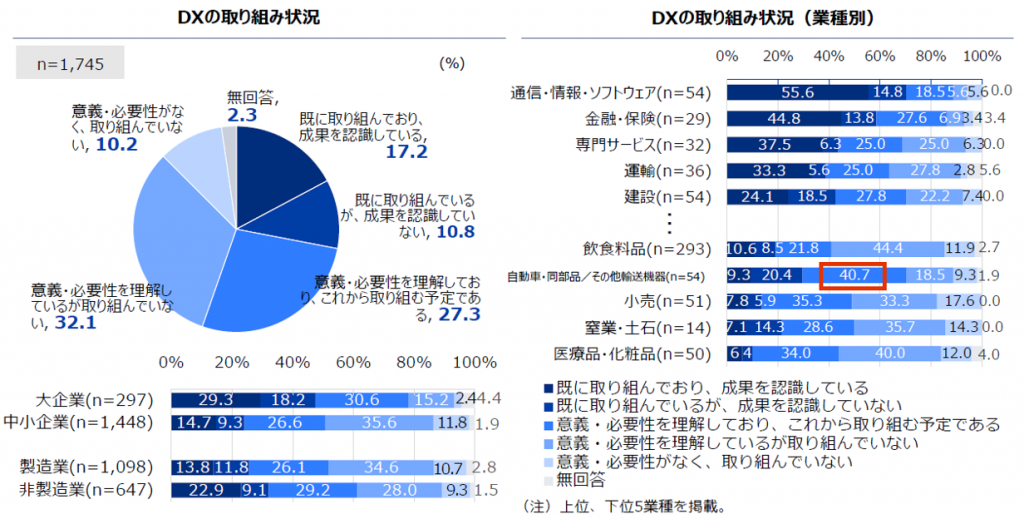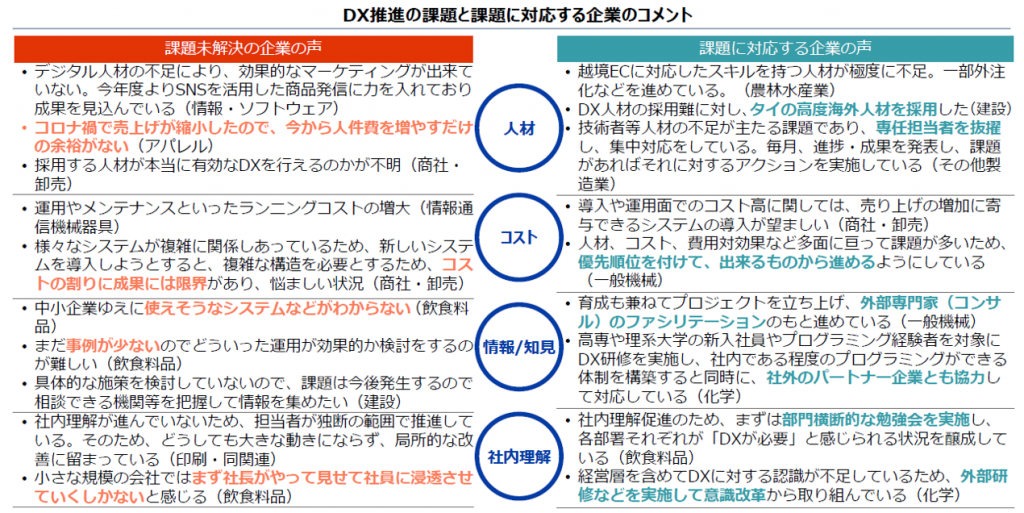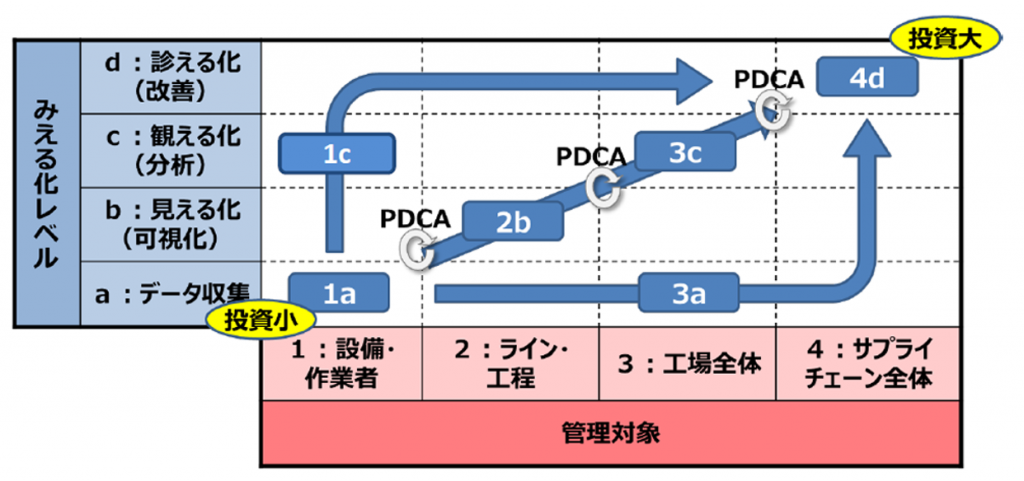DX (Digital Transformation) in the manufacturing industry is the use of digital technology to transform existing businesses and create new value.
In recent years, the impact of COVID-19 has subsided, such as soaring raw material and labor costs, the weak yen, and natural disasters, but the number of issues surrounding factories is increasing day by day. Isn’t sexuality increasing?
In this article, we will explain in an easy-to-understand manner about the DX efforts that do not fail in the Thai manufacturing industry.
Table of contents ∇
1 What is DX?
2 DX status of Japanese companies overseas
2.1 28% are working on DX
2.2 Two issues that come to mind
2.2.1 More than 60% of companies have not introduced DX
2.2.2 Some companies have already introduced DX, but have not been able to realize the results
3 Issues faced by companies
3.1 Issue①「Human resources」
3.2 Issue②「Cost」
3.3 Issue③「Information/Knowledge」
3.4 Issue④「Internal understanding」
4 Solutions to challenges
4.1 Solution①「Hybrid utilization of internal and external human resources」
4.2 Solution②「Scale up from small start」
4.3 Solution③「Participation in external seminars and advice at spots」
4.4 Solution④「Top-down overall optimization」
5 Summary: In order not to fail in DX in the manufacturing industry and Thailand
What is DX?
DX is an abbreviation for Digital Transformation, and it is a hypothesis that “The penetration of IT will change people’s lives for the better in every aspect.” It is said to have been proposed by Eric Stolterman, a professor at Umeå University in Sweden.
The Ministry of Economy, Trade and Industry’s “DX Recommended Guidelines” defines DX as follows.
“Companies can respond to drastic changes in the business environment, utilize data and digital technology, and transform their products, services, and business models based on the needs of customers and society. To transform our culture and climate and establish a competitive advantage.”
In the past, the goal and purpose was to “Improve business efficiency” by utilizing IT and digital technology, but now there is a change in the purpose of “reforming business models and organizations.”
DX status of Japanese companies overseas
X aims to “change business models and organizations”.
Regarding such DX, what is the situation overseas for Japanese companies?
It will explain with reference to the materials sourced from JETRO.
Solution①「Hybrid utilization of internal and external human resources」

This is the result of a questionnaire survey conducted by JETRO from early November to early December 2021 targeting Japanese companies that are highly interested in overseas business, and received responses from 1,745 companies.
When we took a questionnaire about the status of DX initiatives, only about 30% of the 28% of companies who answered that they were already working on it.
By industry, “Communication/Information/Software” had the highest rate of “already working” at 70.4% of the total.
On the other hand, 29.7% of the companies in the “automobiles/automotive parts/other transportation equipment” sector, where many companies have expanded into Thailand, answered “yes” to this question, which is close to the industry average. rate is obtained.
Two issues that come to mind
From the results of the questionnaire survey, we observed the following two issues regarding DX in overseas companies.
1. More than 60% of companies have not introduced DX
2. There are companies that have already introduced DX, but have not realized the results
More than 60% of companies have not introduced DX
According to the results of the questionnaire survey, nearly 60% of companies in the industry as a whole responded that they “understand the significance and necessity of DX in overseas expansion, but are not working on it at this stage.” I’m here. In the same question, if we focus only on the manufacturing industry, it is 60.7%, exceeding the average for the industry as a whole.
It seems that the necessity of DX is understood, but it can be read that the majority of companies have not been able to move to the implementation stage.
Some companies have already introduced DX
On the other hand, 10.8% of the companies that responded that they had already introduced DX said they were not aware of the results.
In the category of “automobiles/automotive parts/other transportation equipment,” where many companies have expanded into Thailand, the percentage was 20.4%, exceeding the percentage of “companies that are realizing results.”
It can be seen that most of the people who have spent time and money to convert to DX have not obtained satisfactory results.
Issues faced by companies
Based on the DX situation of these Japanese companies expanding overseas, JETRO proposes four elements as challenges.
The four issues are “Human resources”, “Cost”, “Information/knowledge” and “Internal understanding”.
These four elements are not complicatedly intertwined, and it is in the form of inducing these two problems that “DX has not been introduced” and “DX has been introduced and the results have not been realized”.

Issue①「Human Resources」
・Effective marketing is not possible due to the lack of digital human resources. From this fiscal year, we have been focusing on disseminating products using SNS, and we expect results (Information/software).
・Since sales have shrunk due to the corona crisis, there is no room to increase labor costs from now on (Apparel)
There is a shortage of digital human resources, and it seems that each company is struggling to acquire human resources. In addition, it seems that it is a source of trouble that the skills of the human resources to be hired are unknown, so they can not take drastic recruitment activities.
In addition, it seems that we are in a dilemma where we want to proceed with DX, but we cannot proceed, such as the fact that we cannot secure human resources to promote DX, due to the impact of our main business due to declining sales and soaring labor costs.
Issue②「Cost」
・Increased running costs such as operation and maintenance (information communication equipment)
・Because various systems are intricately related, when trying to introduce a new system, a complicated structure is required, so the results are limited in relation to the cost, which is a troublesome situation (trading company, wholesale)
I get the impression that the effects of the investment have not been efficiently recovered, such as the increase in running costs due to the introduction of the system, and the increase in functions due to the introduction of the system, which makes the operation complicated and does not produce results. It seems that the challenge is to maximize the effect of system investment.
Issue③ “Information/Knowledge”
・I do not know the system that can be used because it is a small business (food and drink)
・Since there are still few cases, it is difficult to consider what kind of operation is effective (food and drink)
It seems that it is difficult for small and medium-sized companies to set a direction because it is difficult to have a DX specialist team such as a system department or an IT department.
In addition, there are still few examples of DX implementation that are perfect for your company, and it seems that you are having a hard time collecting information.
Issue④「Internal understanding」
・Because internal understanding is not progressing, the person in charge is promoting it at his own discretion. As a result, there is no major movement, and the improvement is limited to local areas (printing/related)
・I feel that in a small company, the president should first demonstrate and instill it in the employees (food and drink).
It seems that efficient introduction is not possible because it works not as an organization but as an individual / department unit. In addition, it seems that the smaller the company, the more it is necessary for the top to act, and it seems that they are concerned about the burden on them.
Solutions to challenges
We propose solutions for four issues that companies are facing.
Here are four solutions:
“Hybrid utilization of internal and external human resources”
“Scale up from small start”
“Participation in external seminars and advice at spots”
“Top-down overall optimization”
By proceeding with these four solutions in parallel, companies can prevent DX failures.
Solution①「Hybrid utilization of internal and external human resources」
It is a solution to “human resources”.
As necessary, it is important to incorporate external knowledge and promote DX together with the internal team.
Recently, due to the shortage of engineers, it is extremely difficult to acquire IT human resources.
Even if you can acquire it, it will be a highly paid human resource, and it will be difficult to coordinate with other human resources.
In addition, in Southeast Asian countries where there is a lot of job hopping, there are cases where people who have paid high costs and acquired human resources are let go.
Therefore, it is necessary to bring in external IT vendors and consulting teams as needed, rather than trying to provide all the necessary human resources in-house.
It is best to promote DX in the necessary parts of the project at an appropriate cost.
However, in promoting DX, it is essential to form an internal team.
The best team composition is to form a team with three people: a person who is responsible for IT in the company, a person who is familiar with the business department, and a person who is familiar with the management department, and an external IT vendor.
Solution②「Scale up from small start」
It is a solution to “cost”.
Set big goals and then set smaller milestones.
Start small with a small goal as an immediate goal.
We will start the project with the minimum human resources and the minimum cost.
By taking a bird’s-eye view and setting goals, you can achieve overall optimization, and by setting small goals, It can also achieve partial optimization at the same time.
Rather than spending a large budget to draw one large pile, it is better to draw many small mountains and create a large pile. It can reduce two points of “Hedging”.
Solution③「Participation in external seminars and advice at spots」
It is a solution to “Information/Knowledge”.
To get information, you have to actively get it.
Recently, the number of business companies, IT vendors, and consulting companies that are actively working on DX is increasing. It is important to participate in seminars hosted by such companies and obtain information. One method is to hold a study group to share the acquired information within the company.
It is also important to invite external IT vendors into the company and obtain information on the spot. It is necessary to consider the solution that suits your company both as a whole and in parts.
Solution④「Top-down overall optimization」
In order to make DX successful, it will not be successful even if it is implemented on an individual or departmental basis.
It must be a company-wide unit and cross-departmental.
It is important to clarify the current “issues” of the entire company, envision the “ideal state”, and clarify the gap between the “issues” and the “ideal state”.
We will clarify the gap, move to “execution” and “verification”, and introduce DX.
In that case, it is necessary for the management layer to take command of the maegashira.
It is necessary for the top management to guide the overall solution and give instructions to each department and person in charge. By presenting firm goals from management, each employee can understand the direction in which the entire company should head.
Management gives top-down instructions, and the staff in charge of each department operates as a working force, making it possible to consider DX solutions that firmly consider “Total optimization” and “Partial optimization.”
In order not to fail in DX in the manufacturing industry and Thailand
For DX in the manufacturing industry, it is important to envision the ultimate goal and start small.
Even in Japanese companies in Thailand, the number of places where data collection using IoT tools is being introduced is increasing.
However, at this stage, I think that the current situation is that the data is not fully utilized.
This is the roadmap to DX set by Mitsubishi Electric Corporation.
Ultimately, it will be a roadmap that aims to acquire information starting from the manufacturing site with factory equipment IoT through a system that links production information and IT, and to analyze and utilize data in real time.
By proceeding from the initial stage of information gathering, it is possible to realize realistic DX that is not unreasonable even at the factory.
By performing a bird’s-eye view analysis of the engineering chain and supply chain, it becomes possible to aim for productivity improvement and cost improvement for manufacturing as a whole.




